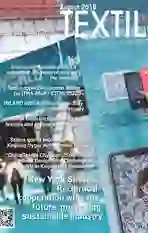Academicians,experts,entrepreneurs gathered to promote the lyocell fiber
2019-10-09
Of the 70 million tons of chemical fibers in the world, the total amount of regenerated cellulose fibers is less than 5 million tons, of which the traditional viscose accounts for the majority. The new solvent-based cellulose fiber (lyocell) has a capacity of less than 300,000 tons, and only 50,000 - 60,000 tons in China. As a green regenerated cellulose fiber, Lyocell has attracted worldwide attention. Chinas new solvent-based cellulose fiber production equipment and technology has reached the international advanced level.
With the increasingly stringent environmental protection policies and the increasing awareness of social responsibility in enterprises and consumption, Lyocell is worthy of vigorous promotion and application.
On July 6th - 7th, “Textile Vision” promotion of lyocells key technologies and applied scientific and technological achievements was held in Shouguang City, Shandong Province. The event was co-organized by the Textile Vision Science & Education Fund, the department of science and technology development of China National Textile and Apparel Council, the Shandong Textile Association and the China Textile Industry Science and Technology Development Center.
Gao Yong, Party Secretary & Secretary-General of China National Textile and Apparel Council, introduced the Textile Vision Science & Education Fund. Since 2011, there have been 47 scientific and technological promotion activities in textile industry organized by the Textile Vision Science & Education Fund. More than 200 scientific and technological achievements have been promoted, which has greatly promoted the development of scientific and technological achievements in the industry. The promotion of regenerated cellulose fibers is a concrete action for the industry to practice green development and promote sustainable development of the textile industry. It will definitely significantly improve the production technology and equipment level of new solvent-based cellulose fibers, and will also serve the structural adjustment of the textile industry, the transformation and upgrading of the regenerated cellulose fibers industry and the green manufacturing of textile fiber raw materials have made positive contributions. To this end, he proposed that the next step should be to do a good job in four aspects:
First, we should strengthen independent innovation. It covers the innovation of the closed-loop sustainable development mode of the whole cycle of products such as green design, green raw materials, green produc- tion and green consumption, and pays attention to the research and development of science and technology from the perspective of the whole industry chain, controls the core technology, and transforms the factordriven growth into innovation-driven growth as soon as possible.
The second is to build independent brands. Strengthen cultural connotation and consumption guidance, enhance the market adaptability of independent brands, develop towards high quality and differentiation, improve quality, level and efficiency, and strengthen automation, digitalization and intelligent transformation.
Thirdly, Shandong textile industry is committed to building a textile industry cluster with Chinese characteristics and international competitiveness. Major projects for the conversion of new and old kinetic energy include advanced basic textile new materials, key emerging strategic fiber new materials and bio-based chemical fibers, giving full play to superior resources and technological advantages, grasping the demand trend and expand the domestic market.
Fourthly, continue to increase the promotion of green manufacturing and green development, enhance consumers understanding of green fiber, and further build a platform for face-to-face learning exchange, product joint development and application promotion for the upstream and downstream of the textile industry chain, and advocate green and low-carbon consumption. idea.
Mr. Gao Yong concluded that with the continuous breakthrough of various basic research, equipment and process technologies in the green cellulose fiber industry and the advancement of industrialization, the industrial application of new solvent-based regenerated cellulose fibers will surely usher in a broad space for development.
杂志排行
China Textile的其它文章
- New report forecasts excellent worldwide outlook for nonwovens through 2023
- Status quo of industrial textiles in Xinjiang Uygur Autonomous Region
- HK Fashion Week S/S:Latest fashion tech equips the industry for market expansion
- MILANO UNICA 29th edition:Italy holds steady
- Yarn Expo exhibitors offer a sustainable,traceable starting point for fashion brands
- July 2019
